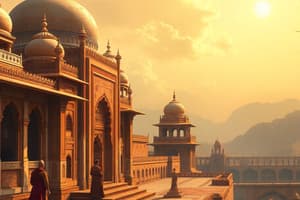Podcast
Questions and Answers
During which Mughal emperor's reign was the world-famous Taj Mahal built?
During which Mughal emperor's reign was the world-famous Taj Mahal built?
- Jahangir
- Akbar
- Shah Jahan (correct)
- Aurangzeb
What factor contributed significantly to the decline of the Mughal Empire in the late 18th century?
What factor contributed significantly to the decline of the Mughal Empire in the late 18th century?
- Invasion by a neighboring empire
- Harmonious blending of cultures
- Religious intolerance
- Economic mismanagement (correct)
Which emperor succeeded Akbar as the fourth Mughal emperor?
Which emperor succeeded Akbar as the fourth Mughal emperor?
- Shah Jahan
- Humayun
- Aurangzeb (correct)
- Jahangir
What event forced Britain to take direct possession of most Mughal possessions other than Bengal in 1857?
What event forced Britain to take direct possession of most Mughal possessions other than Bengal in 1857?
What aspect of governance did the Mughals promote that helped unify diverse Indian populations under their rule?
What aspect of governance did the Mughals promote that helped unify diverse Indian populations under their rule?
Where was Babur born?
Where was Babur born?
What title did Babur assume after defeating Ibrahim Lodi?
What title did Babur assume after defeating Ibrahim Lodi?
Who did Babur leave to rule in India when he returned to Kabul?
Who did Babur leave to rule in India when he returned to Kabul?
Under which Mughal ruler did the empire gain a firm hold over most of Northern India?
Under which Mughal ruler did the empire gain a firm hold over most of Northern India?
What territory did Babur expand into after overthrowing his brother in 1497?
What territory did Babur expand into after overthrowing his brother in 1497?
Flashcards are hidden until you start studying
Study Notes
Mughal Empire
The Mughal Empire was one of the greatest empires in history, founded by Babur, a descendant of Genghis Khan and Tamerlane. It began its rise when Babur invaded India from Afghanistan in 1526. Over time, it became the largest empire in India's history, covering much of the Indian Subcontinent and extending into parts of Iran, Central Asia, and Afghanistan.
Origins and Founding
Babur was born in Fergana Valley in today’s Uzbekistan to Timurid parents. His father was a poet and his mother came from royalty. He inherited the desire for conquest through both bloodlines. In 1497, he overthrew his brother to become ruler of Kabul and later expanded his territory into Punjab, Sindh, Gujarat, and Malwa. Despite these conquests, Babur was never satisfied with what he had achieved. He sought more land and power and set his sights on Delhi.
In 1526, Babur clashed with Ibrahim Lodi, the last independent king of northern India. After defeating him at Panipat, Babur took control of Agra and established himself as the first Mughal emperor. However, despite holding Delhi briefly, Babur did not stay long enough to establish a solid base there. Instead, he returned to Kabul and left his son Humayun to rule in India. After several decades of struggle and several invasions—including one led by Babur from Persia—the Mughals finally gained firm hold over most of Northern India under Akbar the Great.
Expansion and Growth
Under Emperor Akbar, whose forty-year reign is regarded as the pinnacle of Mughal success, the empire reached its zenith. During this period, the Mughals spread their influence across India and extended their reach beyond the country's borders. They created a harmonious blending of different cultures within their territories, promoting secularism and religious tolerance, which helped unify diverse Indian populations under one rule.
Akbar's grandson Shah Jahan built the world-famous Taj Mahal between 1632 and 1653 while ruling during the peak years of the Mughal Empire. The construction of this monument demonstrated how far they had come since the days of humble beginnings. Under Aurangzeb, the fourth Mughal emperor after Akbar, the empire continued to grow. By the late 17th century, the Mughal Empire spanned nearly half of present-day sovereign nations of South Asia including modern Bangladesh, Pakistan, Nepal, Bhutan, India, and Sri Lanka in addition to large swaths of Afghanistan.
However, towards the end of the 18th century, the Mughal Empire entered a phase of decline due mainly to economic mismanagement and political infighting among princes who aspired to succeed the throne. This period coincided with British colonial expansion in India. Eventually, Indian leaders started to revolt against the Mughal rule and accepted British suzerainty instead. Finally, in 1857, the Indian Rebellion forced Britain to take direct possession of all Mughal possessions other than Bengal. Thus ended the reign of one of the mightiest dynasties ever known.
Studying That Suits You
Use AI to generate personalized quizzes and flashcards to suit your learning preferences.




